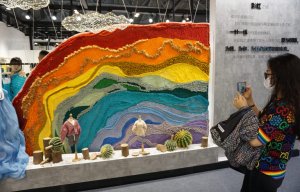
SPINEXPO Shanghai offers fresh stories in 2022
In this article, SPINEXPO, the show for ready-to-wear brand manufacturers with collections of flat-bed and circular knits, wovens, hosiery and new warp seamless knits, focuses on sustainability in textiles and apparel supply chains and previews its forthcoming New York (16-18 July) edition. The exhibition features fibres and yarns for knitwear, weaving and hosiery, as well as knitwear collections from the leading international knitwear manufacturers.

30th May 2013
Knitting Industry
|
New York
In this article, SPINEXPO, the show for ready-to-wear brand manufacturers with collections of flat-bed and circular knits, wovens, hosiery and new warp seamless knits, focuses on sustainability in textiles and apparel supply chains and previews its forthcoming New York (16-18 July) edition. The exhibition features fibres and yarns for knitwear, weaving and hosiery, as well as knitwear collections from the leading international knitwear manufacturers.
“China and other Asian countries have had a bad reputation regarding sustainability in the past, but is this still the case? At SPINEXPO, we have worked with leading spinning and knitwear companies who place sustainability and integrity at the very top of their development pattern. Today they are leading the way to creating better, more environmentally sound and socially responsible textiles.

It has become clear that sustainability and sustainable consumption are not just a fad, but are key issues in today’s textile and apparel business. Every day we are learning new lessons about raw materials, chemicals, and methods of manufacturing in order to improve the sustainable profile of the products we make and sell. But we may be missing a key concept in our efforts: can we reuse more of what we now throw away, and can we change our thinking to design products we are less likely to discard?
In China, the government’s 12th five-year plan has called for the country’s textile businesses to participate in a “circular economy,” which includes water conservation, energy efficiency, alternative bio-based fibres—and producing recycled fibres.
According to a report in Just-Style, China generates around 20 million tons of wasted fabrics annually. Recycling 60% of these fibres would save 4.7 million tons of natural fibres, and 9.4 million tons of chemical fibres.

Closed-loop recycling is not new. In 2000 Teijin Fibers pioneered their ECO CIRCLE™ chemical technology for returning polyester garments back into virgin polymer. Yarns regenerated from natural fibre waste left from spinning and manufacturing processes—wool, cotton, and linen—are enjoying resurgence at the hands of spinners such as France’s Filatures du Parc and Turkey’s Kale Iplik, and have long been a part of the carded wool business in Prato, Italy.
At the retail end, recycling programs such as Marks & Spencer’s Shopping and H & M’s I:Collect are keeping all types of discarded garments out of the landfill with in-store clothing collection schemes. The discards are either sold in charity shops, sent to developing countries to be sold, or broken down and regenerated into yarns to create fabric for new clothing.
But what if garments were developed to be loved and worn for a long time, not to be thrown away? The subject of clothing longevity is being explored by a research team at Nottingham Trent University. Senior Lecturer Helen Hill tells us that the research is examining the reasons garments are thrown away, including consumer attitudes towards fast fashion. She cites a recent report stating that extending clothing life by an extra nine months reduces carbon, water, and waste footprint by 20-30%.

According to Ms. Hill, pilling is often cited as the reason knitwear is discarded, and the development of yarns less likely to pill might prolong the wearable life of our knitwear. For example, Germany Südwolle has been working on small adjustments to its cashmere spinning to make it cleaner, clearer, with less pilling.
SPINEXPO New York will explore this new approach to sustainability with an exhibit developed by Brazilian-born designer Eliana Stefani, using yarns and recycled materials from the spinners Huafu, Novetex and Südwolle. The project is driven by the desire to use natural and recycled materials to create garments and home textiles with both heritage and longevity that will help conserve resources.
 Currently living and working in Bali, Ms. Stefani‘s shop “Lawe” includes recycled furniture, rugs, and hand-made textiles. Her focus is on natural dyestuffs and methods used by traditional and primitive cultures; lawe is the local name for the yarn spun from Java’s brown cotton. Ms. Stefani believes that sustainability and creativity go hand in hand. “Every process has to have conscience and requires creativity to deal with issues that come up when we try to follow the sustainable path all the way,” she explains.
Currently living and working in Bali, Ms. Stefani‘s shop “Lawe” includes recycled furniture, rugs, and hand-made textiles. Her focus is on natural dyestuffs and methods used by traditional and primitive cultures; lawe is the local name for the yarn spun from Java’s brown cotton. Ms. Stefani believes that sustainability and creativity go hand in hand. “Every process has to have conscience and requires creativity to deal with issues that come up when we try to follow the sustainable path all the way,” she explains.
Ms. Stefani will be creating a range of products using top-dyed melange yarns, along with organic, recycled, and BCI cottons, and blends of Pima cotton with cashmere, or cotton with wool or linen. “When it comes down to the garments we love the most, they are the ones where the fibres feel right on the body. They are soft and comfortable,” she believes.
The project, which will be introduced at the SPINEXPO New York July edition, continues to evolve, with research into potential collaborators, indigenous techniques, and cultural heritages to be finalised at SPINEXPO Shanghai in September.
SPINEXPO celebrates this thoughtful and sustainable approach to design.
“Interactions” SPINEXPO Autumn/Winter 2014/15
 As a theme for our trends at SPINEXPO, Evolutions became a very powerful message that created an intensity for all that visited. It raised many questions, and created a new energy that has remained long after the Spring/Summer show passed.
As a theme for our trends at SPINEXPO, Evolutions became a very powerful message that created an intensity for all that visited. It raised many questions, and created a new energy that has remained long after the Spring/Summer show passed.
The most powerful of these reactions has been the desire we feel for people to join together and communicate about what they are feeling and where they want to go, taking part, and how people can connect and become part of a whole.
This evolved into our direction for Autumn Winter 2014/15, taking this desire to interact more and have it flow into all aspects of our creativity starting with colour and yarn.
As with Evolutions we continue to explore colour tonally. We feel colour should be used like a language to express ourselves. Colour is naturally linked to our deep emotions and how we make sense of the world, something we all see differently.
Everyone’s perception of colour develops uniquely based on their own influences of language, nationality, history, climate, age and culture. Today as we interact more around the world through travel and the Internet a new language is being created, a visual language that has its foundation in colour and fabric because we can communicate visually with no need for translation.
Colour is no longer directed by others or themes. It has become an individual choice based on our personal interactions. At SPINEXPO we have assembled new levels of colour that we feel are taking a direction with softer, richer hues, bathed in a positive glow of warmer tones and matched them to evolutions in yarns.
How we perceive a colour is dependent on the colours it interacts with, a lesson we should apply to all aspects of our lives to make us more successful, balanced and harmonious. These different lifestyle aspects and influences and how they interact have been explored in eight new colour levels, but how these levels and yarns are perceived and can interact together is up to you.
SPINEXPO New York will present a very complete seminar program: directions in trends, merchandising, sustainability, new concepts in knitwear, as well as new technology. The full program will be announced shortly.”
SPINEXPO – New York
5th edition
Featuring Autumn/Winter 2014/15 Collections
International Textile Exhibition
Yarns – Fibres – Knitwear & Knitted Fabrics
Innovative Software for Textile Machinery & Creative Trend Developments
16-17-18 July 2013
Metropolitan Pavilion, 125 West 18th Street, New York NY 10011
SPINEXPO – Shanghai
22nd edition
3-4-5 September 2013
Shanghai Pudong Expo Centre – China
201 He Huan Road – Crossing Ying Chun Road
Pudong New Area District
Shanghai 201314

Business intelligence for the fibre, textiles and apparel industries: technologies, innovations, markets, investments, trade policy, sourcing, strategy...
Find out more